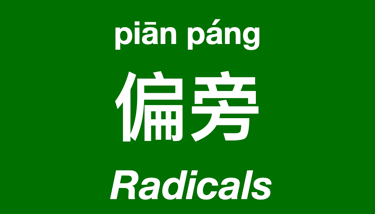

Understanding Chinese Character Components: 偏旁, 部首, and 声旁
偏旁 (Piānpáng)
偏旁 refers to the components or parts of Chinese characters that contribute to their meaning or pronunciation. These components can be radicals (部首) or phonetic elements (声旁). Characters are often composed of one or more of these parts.
部首 (Bùshǒu)
部首 (radical) is a key component of a Chinese character that often indicates the character's meaning or semantic category. Radicals are used to organize Chinese dictionaries and are essential for understanding and learning Chinese characters. There are 214 traditional radicals in Chinese.
Examples of Radicals:
- 氵 (Three dots water): Related to water or liquids. Example: 河 (hé, river).
- 木 (Tree): Related to wood or trees. Example: 林 (lín, forest).
- 口 (Mouth): Related to speech or the mouth. Example: 吃 (chī, eat).
声旁 (Shēngpáng)
声旁 (phonetic component) is a part of a Chinese character that gives a clue to its pronunciation. Phonetic components are combined with radicals to form new characters, often sharing a similar pronunciation.
Examples of Phonetic Components:
- 青 (qīng) in 清 (qīng, clear) and 请 (qǐng, please).
- 马 (mǎ) in 吗 (ma, question particle) and 妈 (mā, mother).
Combining Components:
Chinese characters often combine a radical (semantic component) and a phonetic component to form a complete character. For example:
- 河 (hé, river):
- Radical: 氵 (Three dots water) indicating it is related to water.
- Phonetic component: 可 (kě) giving a clue to the pronunciation.
Summary:
- 偏旁 (Piānpáng): Components or parts of Chinese characters.
- 部首 (Bùshǒu): Radicals that indicate the character's meaning or semantic category.
- 声旁 (Shēngpáng): Phonetic components that provide clues to the character's pronunciation.
Understanding these components helps in learning, recognizing, and remembering Chinese characters. Would you like to explore specific characters and their components?
